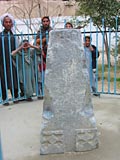|
The Cloak of the Prophet
Religious Artifact at the Heart of Former Taliban Stronghold
 Listen to Steve Inskeep's story on the Cloak of the Prophet. Listen to Steve Inskeep's story on the Cloak of the Prophet.
Jan. 10, 2002 -- In Kandahar stands a shrine that is regarded by some as the heart of Afghanistan. Like many buildings in this bombed-out city, the shrine of Kharka Sharif is decorated with the flag of Afghanistanís new government (which is also the flag of its exiled former king). But a very different flag flew here until just a few weeks ago, and an artifact in this shrine played a role in the rise of the Taliban.
The shrine is the home of a cloak that supposedly belonged to the Prophet Mohammed. Itís locked away in an ornate building and is almost never viewed by the public. Behind that building stands the tomb of Ahmad Shah Durrani, the king whose family built the modern Afghan state starting in the 1700s.
For generations, Afghans have passed down a story about both the cloak and the king. Whether itís precisely true or not, the story is often reprinted in history books, and when I visited the shrine the other day, Afghans repeatedly asked if I had heard the tale.

|
|
According to legend, this stone was taken along with the Prophet's cloak from the northern Afghanistan city of Badakhashan.
Photo: Steve Inskeep, NPR
 click for larger picture click for larger picture
|
Most American children have heard the fable about George Washington and the cherry tree ("I cannot tell a lie.") When they tell about the father of their country, Afghans describe a man who apparently lacked Washington's aversion to shading the truth.
According to the version of the legend that I heard, Ahmad Shah traveled to Bokhara -- once one of the major centers of Islamic scholarship and culture, now a modern city in the former Soviet state of Uzbekistan . There he saw the sacred Cloak of the Prophet Mohammed, and decided to bring it home. He wanted Kandahar to have the artifact, so he asked to "borrow" the cloak from its keepers.
The keepers knew he might steal it, and told him he must not take the cloak from Bokhara. So Ahmad Shah pointed to a stone in the ground and made a promise. He said, "I will never take the cloak far away from this stone."
Relieved, the keepers let him take the cloak. Ahmed Shah kept his word, in a sense. He had the stone taken up out of the ground, and had it carried back to Kandahar, along with the cloak, which he never returned. Today, the stone stands on a pedestal near the shrine.
The Cloak of the Prophet is normally hidden from public view. It is taken out only for special occasions. The last such occasion came in 1996, as the Taliban seized control of the country.
The Taliban leader, Mullah Omar, made what was considered a brilliant propaganda move. He took Mohammed's shroud out of storage and wore it in a public rally, as a way to identify himself with the Prophet, and give himself legitimacy.
Looking around the grounds of the shrine, you see what, for all we know, may be part of the legacy of Omar's rule. There are other graves in the ground around the tomb of Ahmed Shah.
Some of the graves appear to be fresh.
 Browse more NPR stories on Kandahar. Browse more NPR stories on Kandahar.
In Depth
 Inskeep's photos of war-ravaged Afghanistan from Dec. 10, 2001. Inskeep's photos of war-ravaged Afghanistan from Dec. 10, 2001.
 Pictures and audio from Afghanistan by NPR correspondent Eric Weiner. Pictures and audio from Afghanistan by NPR correspondent Eric Weiner.
Other Resources
• Lonely Planet Guide: Afghanistan
• Afghan-Info.com
|